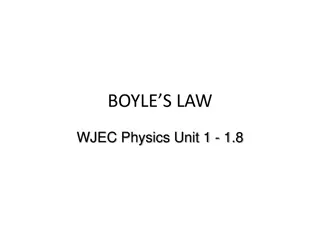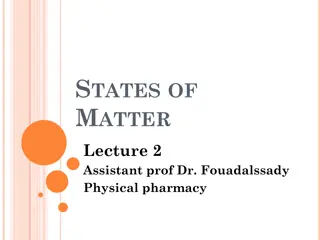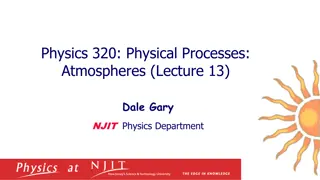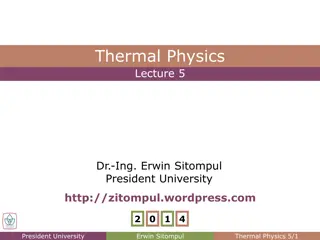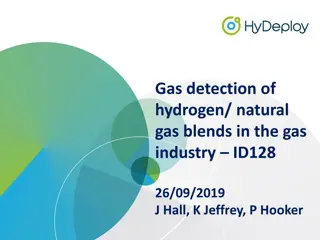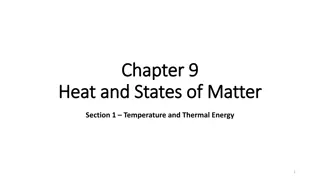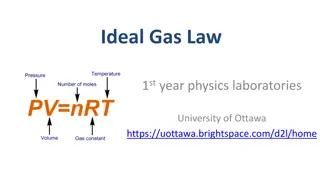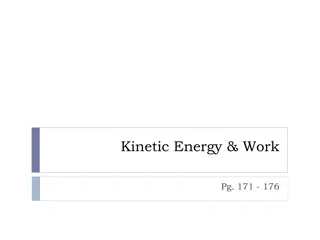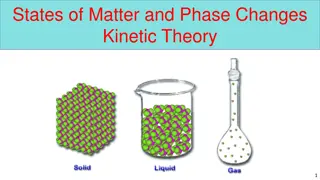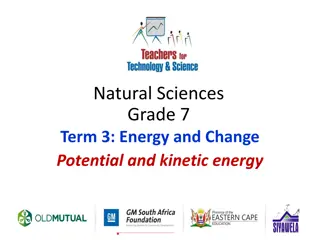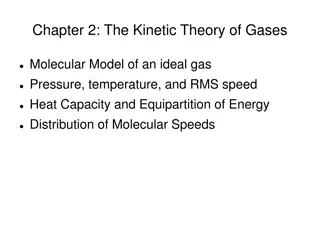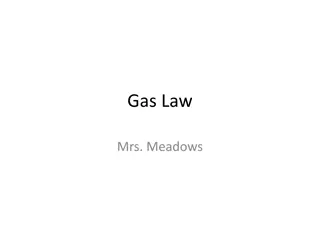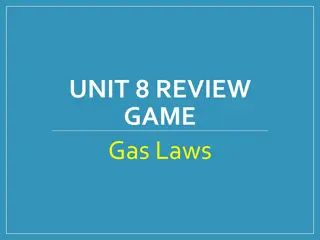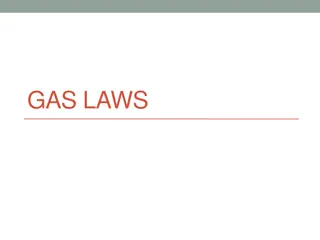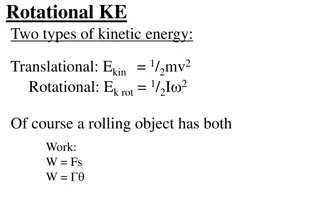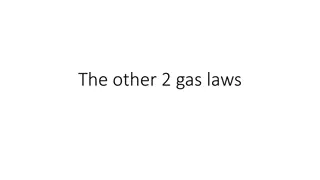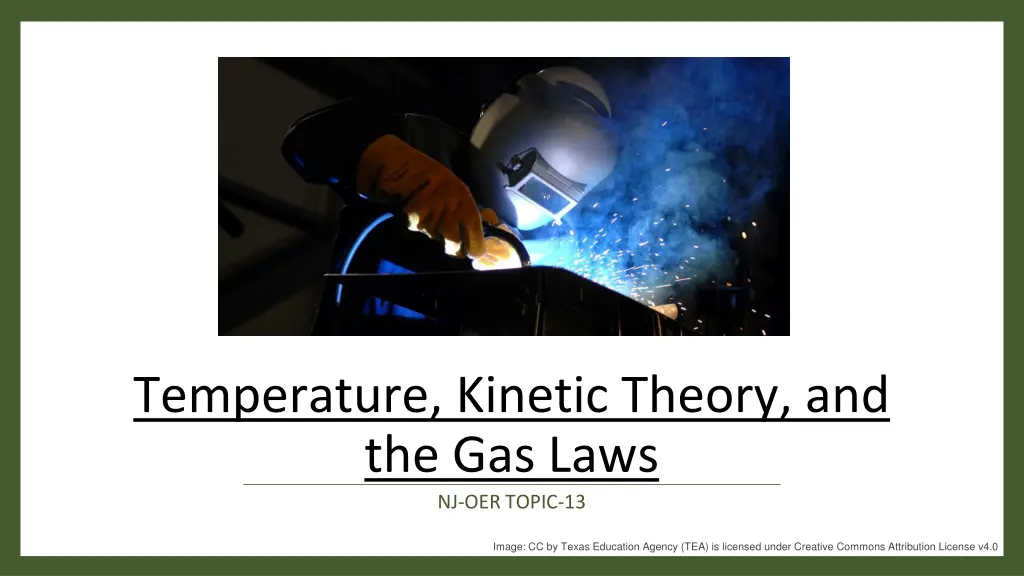
Understanding Temperature, Kinetic Theory, and Gas Laws
Explore the concepts of temperature, kinetic theory, gas laws, and their applications in physics. Learn about temperature conversions, thermal expansion, ideal gas law calculations, kinetic energy relationships, and more through comprehensive learning outcomes.
Uploaded on | 0 Views
Download Presentation

Please find below an Image/Link to download the presentation.
The content on the website is provided AS IS for your information and personal use only. It may not be sold, licensed, or shared on other websites without obtaining consent from the author. If you encounter any issues during the download, it is possible that the publisher has removed the file from their server.
You are allowed to download the files provided on this website for personal or commercial use, subject to the condition that they are used lawfully. All files are the property of their respective owners.
The content on the website is provided AS IS for your information and personal use only. It may not be sold, licensed, or shared on other websites without obtaining consent from the author.
E N D
Presentation Transcript
Temperature, Kinetic Theory, and the Gas Laws NJ-OER TOPIC-13 Image: CC by Texas Education Agency (TEA) is licensed under Creative Commons Attribution License v4.0
Original Publication Year 2022 General Physics I by Moe Tabanli is licensed under aCreative Commons Attribution-NonCommercial-ShareAlike 4.0 International License, except where otherwise noted. To learn more about the Open Textbook Collaborative, visit https://middlesexcc.libguides.com/OTCProject Under this license, any user of this textbook or the textbook contents herein must provide proper attribution as follows: If you redistribute this textbook in a digital or print format (including but not limited to PDF and HTML), then you must retain this attribution statement on your licensing page. If you redistribute part of this textbook, then you must include citation information including the link to the original document and original license on your licensing page. If you use this textbook as a bibliographic reference, please include the link to this work https://opennj.net//physics- tabanli in your citation. For questions regarding this licensing, please contact library@middlesexcc.edu Funding Statement This material was funded by the Fund for the Improvement of Postsecondary Education (FIPSE) of the U.S. Department of Education for the Open Textbooks Pilot grant awarded to Middlesex College (Edison, NJ) for the Open Textbook Collaborative. Open Textbook Collaborative The Open Textbook Collaborative. (OTC) project is a statewide project managed by Middlesex College along with assistance from Brookdale Community College, Ocean County College , Passaic County Community College, and Rowan University . The project engages a consortium of New Jersey community colleges and Rowan University to develop open educational resources (OER) in career and technical education STEM courses. The coursesalign tocareer pathways in New Jersey s growth industries including health services, technology, energy, and global manufacturing and supply chain management as identified by the New Jersey Council of Community Colleges.
Convert temperatures between the Celsius, Fahrenheit, and Kelvin scales. Define, describe and calculate thermal expansion State the ideal gas law in terms of molecules and in terms of moles. Use the ideal gas law to calculate change in pressure, temperature, volume or the number of molecules or moles State the relationship between the kinetic energy, temperature and root mean square velocity of a gas Interpret a phase diagram. State Dalton s law. Learning Outcomes
P = Pressure ?? = Temperature in Fahrenheit V= Volume T? = Temperature in Celsius NA = Avogadro number ?=TK=Temperature in Kelvin N= number of atoms or molecules ??=Expansion (Lf-L0) Concepts n= number of moles L = Original length m =mass of molecule in kg ? = Coefficient of linear expansion M= molar mass in kg/mole vrms = Root mean square of speed of a molecule ?=universal Boltzmann constant R = 8.31 J/ (mole K) universal gas constant
SI UNITS Volume is in cubic meters m3 Pressure is in Pascal Pa Temperature in Kelvin K Energy in Joules J vrms in meters per second m/s R is in J/ (mole K) K is in J/K Units
TF= 9/5 TC +32 TK= TC +273.15 ??=???? A= 2?A T V=3?V T ??=??? ??= ??? P1 V1/(n1 T1)=P2 V2/(n2 T2) ?=1.38 10 23 ?/? ?=8.31???? ? n/N=R/k=NA= 6.02 1023??? 1 KE = 3/2 nRT = 3/2 NKT for monatomic gas vrms = sqrt (3RT/Mm) Mm is the molar mass Formulas and Constants
CLASSWORK FOR UNIT CONVERSIONS Complete the table below for unit conversion using the given temperature TF= 9/5 TC +32 TK= TC +273 TC(Celcius) TF(Fahrenheit) TK(Kelvin) 90 ? ? ? 100 ? ? ? 300 300 ? ? ? 212 ? ? ? 0 Solution for the first row: TK=90+273=363Kelvin TF=(9/5)90+32=204 Fahrenheit
CLASSWORK FOR THERMAL EXPANSION Complete the table below Object Alpha Initial Measurement Ti Tf Change 16.7 10-6 Copper Wire Length=? 30 C 230 C L=0.03 23.0 10-6 A= - 0.02 m2 Aluminum Plate L=5meters W=3meters 70 degrees C ? Unknown Plate ? L=4 meters W=2meters 23 C 73 C A=0.005 m2 16.7 10-6 Copper Sphere Radius 0.4 meters 30 C 70 C V=? V(sphere)=4/3 r3 ??=???? A= 2?A T V=3?V T Model word problem for the first row: A copper wire is heated from 30 degrees celcius to 230 degrees Celcius. As a result it expanded by 0.03 meters. What was the original length. Solution:0.03 = L (16.7 10^-6)(230-30) L=89.8 meters
IDEAL GAS An ideal gas is a hypothetical gas composed of randomly moving point size gas molecules where interparticle interactions are negligible.
CLASSWORK: IDEAL GAS STATES ??=??? Volume is in cubic meters m3 Pressure is in Pascal Pa Temperature in Kelvin K ??= ??? ?=1.38 10 23 ?/? ?=8.31???? ? Q: Three moles of ideal gas has 100,000 Pascal pressure at 242 degrees Kelvin. What is its volume ? n=3 P=100,000 V=? T=242 V=nRT/P V= 0.06 m3 Complete the table below, use unit conversion if necessary. Pressure Volume number Constant Temperature 100,000 Pa ? 3 moles R 242K 0.2 m3 1 atm ? R 600K 75 kPa 0.15 gallon ? R -10 Celcius 8 10(-18) m3 ? 1000 molecules k 400 K TK=TC+273 1 atm=101,325 Pascal 1kPa=1 kilopascal=1000 Pascal 1 Gallon=0.003785 m3
IDEAL GAS PROCESS EQUATION P1 V1/(n1 T1) = P2 V2/(n2 T2) This is a comprehensive equation for a gas going from State 1 to State 2 Each state has Pressure Volume Temperature and number of moles or molecules If any of the variables is a constant, they could be crossed out Above equation is unit independent, as long as units are consistent for both states. The only unit that must be used is Temperature in Kelvin.
IDEAL GAS PROCESSES Some Typical Systems with Constants Figure 2.. Figure 1. Figure 3.. Sealed piston has moveable walls. P T V can change but number of moles is constant Hot air balloon has elastic surface and exposed to atmospheric pressure. P is constant Sealed solid container has constant volume. It has constant number of moles unless it leaks or gas is pumped Figure 3: 20lb. Steel Propane Cylinder by Hustvedt is licensed under the Creative Commons Attribution-Share Alike 3.0 Unported License Figure 1: CC by Texas Education Agency (TEA) is licensed under Creative Commons Attribution License v4.0 Figure 2: Engine, Partial Cross-Sectional View by MJ Bird is licensed under the Creative Commons Attribution-Share Alike 3.0 Unported License
KEY STRATEGIES Identify the variables for the initial state, label them with index "1" Identify the variables for the final state, label them with index "2" Use the ideal gas process equation. If anything is constant, cross it out from both sides. Solve for the unknown. Unknown will have the unit of the other state variable
IDEAL GAS PROCESS CLASSWORK 3 Moles of gas has pressure 100,000 Pascal is at 250-degree Kelvin. What happens to the pressure if temperature is raised to 300-degree Kelvin and 0.5 moles of gas is added under constant volume. P1=100,000Pa n1=3 T1=250K P2=? n2=3.5 T2=300K V1=V2 P1V1/(n1 T1) = P2 V2/(n2 T2) cross out the V's
ACTIVITY IDEAL GAS PROCESSES Open Phet simulation https://phet.colorado.edu/sims/html/gas- properties/latest/gas-properties_en.html Click on ideal. Click on width. The container is 10nm width, 10nm height and there is an unseen depth, which is 3.5nm 1nm=10^-9 meters. So the original box has volume V=0.035 10^-23 m3 Click on particles. You can adjust number of particles inside the container You may add heat to the system and observe the temperature change The activity is about calculating the pressure and comparing with the values of the pressure gauge. Change the units of pressure gauge to kilopascal kPa. 1kPa=1000 Pa. Pressure is caused by particles hitting the walls of the container. If fluctuates statistical uncertainties. Make sure your calculated pressure is within the range of what pressure gauge reads. You can see a minimum pressure and maximum pressure. Image: University of Colorado simulation site: Simulation by PhET Interactive Simulations, University of Colorado Boulder, licensed under CC-BY-4.0 (https://phet.colorado.edu)
ACTIVITY IDEAL GAS PROCESSES Open Phet simulation https://phet.colorado.edu/sims/html/gas-properties/latest/gas-properties_en.html Calculate Pressure using P1V1/(N1 T1)=P2V2/(n2 T2) for the problems below. Simulate the problem using the app and compare the Pressure read from the gauge. 100 gas molecules is inside a container with 0.035 10-23m3Volume It has about 1200 kPa pressure at 300K temperature. 1) Find the new pressure if 50 more molecules are pumped at constant volume and temperature 2) Find the new pressure if 50 more molecules are pumped at constant volume but temperature is increased to 350K 3) Find the new pressure if 50 more molecules are pumped, temperature is raised to 350K and volume is halved. 4) Come up with your own questions. Compare you measure pressure with the pressure given by the pressure gauge. Image: University of Colorado simulation site: Simulation by PhET Interactive Simulations, University of Colorado Boulder, licensed under CC-BY-4.0 (https://phet.colorado.edu)
CLASSWORK FOR KINETIC THEORY OF GAS KE = 3/2 nRT = 3/2 NKT for monatomic gas vrms = sqrt (3RT/Mm) Mm is the molar mass Molar mass of a monatomic gas is 0.040 kg/mol Calculate the Kinetic energy and root mean square velocity at A) 300 K B) 600 K C) 10 K
CLASSWORK FOR PHASE CHANGE A substance has the triple point at 0.02 atm pressure and at 5 degrees Celcius temperature. Q1) Draw an approximate P T diagram for the substance near its triple point.(Draw only near the triple point as a partial graph since the slopes will change as we move away from the triple point). Consider A) Slope of the sublimation curve is 0.8 atm/C B) Slope of the evaporation curve is 0.2 atm/C C) Slope of the melting curve is 4 atm/C Q2) Identify 6 points on the graph, one for each pure state and one for each phase transition PT graph for water is given as reference, the image for the particular gas in the question will be different. Image: CC by Texas Education Agency (TEA) is licensed under Creative Commons Attribution License v4.0
REFERENCES Slide 1: Open Stax College Physics online textbook Slide 8: Adobe id= 437739805 Gas equation on blackboard, ideal gas law equation, combine gas law equation, gas law of chemistry and physics By BN Benz Slide 11 Left image: Open Stax College Physics online textbook Slide 11 Middle image: Mj-bird, CC BY-SA 3.0, via Wikimedia Commons Slide 11 Right image: Hustvedt, CC BY-SA 3.0, via Wikimedia Commons Slides 14-15: Screenshot from PhET Interactive Simulations University of Colorado Boulder Slide 17: Open Stax College Physics online textbook




